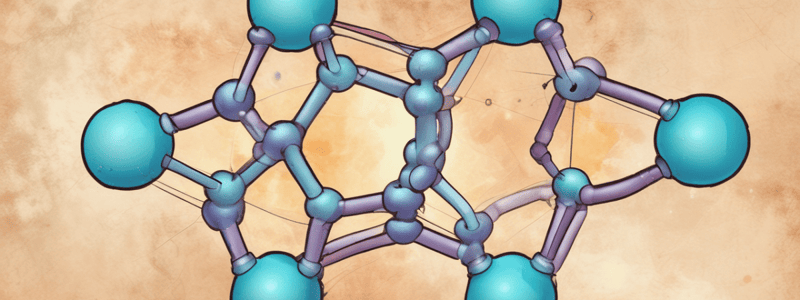Podcast
Questions and Answers
What is the defining characteristic of Lewis acids?
What is the defining characteristic of Lewis acids?
- They are electrophilic (correct)
- They are electron-donating
- They are nucleophilic
- They donate an electron pair
Which of the following is NOT an example of a Lewis base?
Which of the following is NOT an example of a Lewis base?
- Silver ion (Ag+) (correct)
- Bromide ion (Br-)
- Water (H2O)
- Ammonia (NH3)
What type of bond is formed in a Lewis acid-base reaction?
What type of bond is formed in a Lewis acid-base reaction?
- Hydrogen bond
- Covalent bond (correct)
- Metallic bond
- Ionic bond
Which of the following species is a Lewis acid?
Which of the following species is a Lewis acid?
What is the role of the Lewis base in a Lewis acid-base reaction?
What is the role of the Lewis base in a Lewis acid-base reaction?
Which of the following statements about Lewis acid-base reactions is true?
Which of the following statements about Lewis acid-base reactions is true?
What type of bond is formed in a Lewis acid-base reaction?
What type of bond is formed in a Lewis acid-base reaction?
How does a Lewis acid differ from a Brønsted-Lowry acid?
How does a Lewis acid differ from a Brønsted-Lowry acid?
In a Lewis acid-base reaction, what does the Lewis acid typically do?
In a Lewis acid-base reaction, what does the Lewis acid typically do?
What is the key difference between Lewis acids and Brønsted-Lowry acids?
What is the key difference between Lewis acids and Brønsted-Lowry acids?
Why does a Lewis acid-base reaction not require electronegativity differences?
Why does a Lewis acid-base reaction not require electronegativity differences?
Which theory extends the definition of acids and bases in chemistry beyond proton transfer?
Which theory extends the definition of acids and bases in chemistry beyond proton transfer?
Flashcards are hidden until you start studying
Study Notes
Lewis Acids and Bases
Lewis acid-base reactions, also known as coordinate covalent bonds, are a type of chemical reaction that does not involve proton transfer. Instead, they involve the interaction between a Lewis acid, which accepts an electron pair, and a Lewis base, which donates an electron pair. These reactions result in the formation of an adduct, which is a complex between the Lewis acid and the Lewis base.
Lewis Acids
Lewis acids are species that accept an electron pair. They are electrophilic, meaning they are electron-attracting. When bonding with a base, the acid uses its lowest unoccupied molecular orbital (LUMO). Examples of Lewis acids include:
- Boron trifluoride (BF3)
- Aluminum chloride (AlCl3)
- Silver ion (Ag+)
Lewis Bases
Lewis bases are species that donate an electron pair. They are nucleophilic, meaning they are electron-donating. Examples of Lewis bases include:
- Halides, such as bromide (Br-) and chloride (Cl-)
- Water (H2O)
- Ammonia (NH3)
- Hydroxide ion (OH-)
Lewis Acid-Base Reactions
Lewis acid-base reactions result in the formation of a coordinate covalent bond between the Lewis acid and the Lewis base. This bond is just a type of covalent bond in which one reactant gives an electron pair to another reactant. When they react in this way, the resulting product is called an addition compound or more commonly an adduct.
An example of a Lewis acid-base reaction is the interaction between ammonia (NH3) and boron trifluoride (BF3):
NH3 + BF3 → NH3:BF3
In this reaction, the nitrogen atom in ammonia (NH3) donates a pair of electrons to the boron atom in boron trifluoride (BF3), forming a coordinate covalent bond.
No Electronegativity
One of the key differences between Lewis acids and bases and Brønsted-Lowry acids and bases is that Lewis acids and bases do not require electronegativity differences between the acid and the base. In Brønsted-Lowry acid-base reactions, the acid is more electronegative than the base, which allows the acid to donate a proton to the base. However, in Lewis acid-base reactions, the acid accepts an electron pair from the base, which does not require electronegativity differences.
For example, in the reaction between ammonia (NH3) and boron trifluoride (BF3), there is no electronegativity difference between the acid and the base. However, the electron-deficient boron atom in BF3 accepts a pair of electrons from the electron-rich nitrogen atom in NH3, forming a coordinate covalent bond.
In summary, Lewis acids and bases are important concepts in chemistry that extend the definition of acids and bases beyond the proton-transfer-based Brønsted-Lowry theory. These reactions, known as Lewis acid-base reactions, involve the interaction between a Lewis acid, which accepts an electron pair, and a Lewis base, which donates an electron pair. These reactions do not require electronegativity differences and result in the formation of a coordinate covalent bond.
Studying That Suits You
Use AI to generate personalized quizzes and flashcards to suit your learning preferences.




